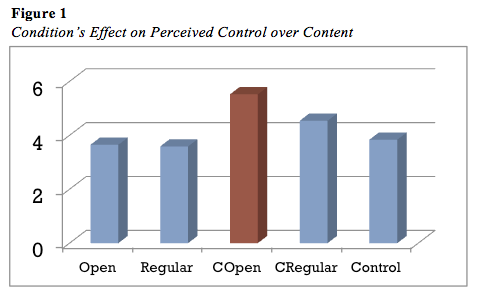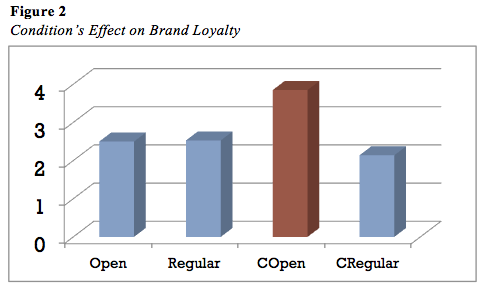Media Effects Research Lab - Research Archive
Interrupting entertainment online:
Student Researcher(s)
Keunyeong “Karina” Kim (Ph.D Candidate);
Drew D. Shade (Ph.D Candidate);
Elise M. Stevens (Masters Candidate);
Faculty Supervisor
INTRODUCTION
Online television platforms (e.g., Hulu, CBS.com, etc.) encourage users to individualize their own television viewing experience through customizable features built into those interfaces (Chamberlain, 2010). Due to customization, there is “no standard way of experiencing television” (Simon & Rose, 2010, p. 52). Among the many customizable features possible, the current study presented tested for the effects of content customization—adjusting advertisement placement in a television episode—on perceived control over the content, brand loyalty to the products featured in the advertisements, media enjoyment, narrative engagement and behavioral intentions to use and share online television platforms.
RESEARCH QUESTION / HYPOTHESES:
1. Perceived control over content
Customizable features offer users perceived control over content in four different ways (Marathe & Sundar, 2010). First, modifiable features simply enhance a sense of control by forming perception of “self as a source” (Sundar, 2008, p. 66). Additionally, contributing to content with customizable features provides users with greater predictability over the content they will experience. Finally, interfaces with customizable options allow users to initiate actions on media content and make their own choices when shaping their media viewing experience (Marathe & Sundar, 2010).
H1: The participants with content customization will have greater perceived control over content than those without content customization.
2. Brand loyalty
Customization can lead to positive attitudes and behaviors toward customized objects (Kalyanaraman & Sundar, 2006). Particularly, customizable features are beneficial for both businesses and customers in regards to brand loyalty (Schrage, 1999). In the gaming context, it has been found that customization increases gamer loyalty to certain types of games (Teng, 2010), which leads to stable revenue and often a competitive advantage (Reichheld & Schefter, 2000). Thus, customizing advertisement placement may increase brand loyalty among users.
H2: The participants with content customization will have greater brand loyalty than those without content customization.
3. Narrative engagement and media enjoyment
To enjoy narrative content, viewers have to be fully immersed into the story (Green & Brock, 2004). However, a strong feeling of immersion into a narrative is hard to achieve when the media structure does not allow a user to fully employ their cognitive capacities in processing media content. According to Lang’s Limited Capacity Model (2009), one’s finite capacity is allocated into processing the media content and the media structure based on one’s own goal and interests. Therefore, customization might impede engagement into the narrative, which may result in less media enjoyment.
H3: The participants with content customization will have less narrative engagement than those without content customization.
H4: The participants with content customization will have less media enjoyment than those without content customization.
However, customization may actually lead users to experience greater narrative engagement and media enjoyment if the performed customization actually helps improve the media viewing experience. Customizing content will allow viewers to diminish or avoid interruption of advertisements. In many online television platforms, viewers are able to skip advertisements so that the ads do not interfere with the flow of media exposure (Ha, 2003).
H5: The participants who choose opening advertisement interruption will have greater (1) narrative engagement and (2) media enjoyment than those that choose regular advertisement interruption.
4. Behavioral intentions to use and share online television platforms
Online television interfaces with customizable features not only receive great attention from television content consumers, but also create consumer loyalty (Kalyanaraman & Sundar, 2006). With a variety of customizable functions, online television platforms shift television viewing from standard viewing into customized viewing. In that regard, it is important to assess the effects of content customization on behavioral intentions toward online television platforms.
RQ1: Will participants with content customization show intentions to use online TV platforms?
RQ2: Will participants with content customization show intentions to share online TV platforms?
METHOD
Participants (N = 75) in the between-subjects experiment were exposed to a 20-minute comedic episode and were randomly assigned to one of the five different advertisement conditions. The conditions included: (1) watching all the advertisements before the episode (Open), (2) watching the episode with regular advertisement interruption (Regular), (3) choosing to view the advertisements before the episode and the use of a slider bar (COpen), (4) choosing to view the episode with regular advertisement interruption and the use of a slider bar (CRegular), and (5) watching no advertisements at all (control group). After watching the episode, participants were asked to assess primary dependent variables, including perceived control over content, perceived brand loyalty, media evaluation, narrative engagement, and behavioral intentions to use and share online television platforms.
RESULTS
H1: Partially supported. Perceived control had significant relationships with the content customization conditions. Findings showed that choosing advertisement placement before the episode (Copen) resulted in more perceived control when compared to the other conditions.

H2: Partially supported. Brand loyalty had significant relationships with the content customization condition. Findings showed that choosing advertisement placement before the episode (Copen) resulted in more perceived control when compared to the other conditions

H3: Not supported. There was no significant relationship found between content customization and narrative engagement.
H4: Not supported. There was no significant relationship found between content customization and media enjoyment.
H5: Not supported. There was no significant relationship found between the different content customization conditions (copen vs. cregular) and both narrative engagement and media enjoyment.
RQ1 & RQ2: There were no significant relationships found between content customization and behavioral intentions to use and share online television platforms.
DISCUSSION/ CONCLUSION
Findings from this study showed that choosing advertisement placement before the television episode produces greater perceived control over content and brand loyalty when compared to the other conditions. This indicates that a user’s sense of control and brand loyalty is enhanced not by simply having a choice to customize the advertisement placement, but by the results of the performed customization. A sense of control was fulfilled only when the performed customization actually helped reduce potential advertisement interruptions. Similarly, brand loyalty was also achieved when the advertisements did not interrupt the media viewing experience. This might be because people were pleased with the benefits of the customization or because the customization was more noticeable than the other customization condition.
For more details regarding the study contact
Dr. S. Shyam Sundar by e-mail at sss12@psu.edu or by telephone at (814) 865-2173

